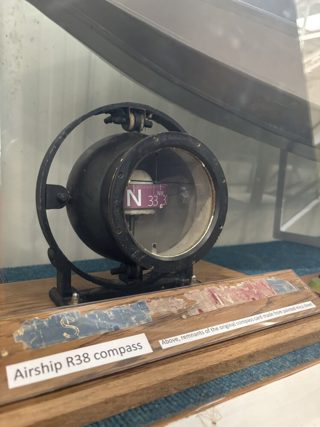H. Hughes & Son Navigational Compass From R38 Airship
The artefact was recovered from the wreckage of the R38 – the then largest airship ever built – after it crashed in Howden, in 1921.
The R38 airship was originally commissioned in spring of 1918 as a counter weapon to the Zeppelin. However, building was not completed at the Cardington hangars until the war had ended. Instead, a deal was struck with the United States of America for the purchase of the airship – then, the largest airship ever built at 699ft long, 86ft in diameter, and with a capacity of 2,750,000ft³.
After successful flight tests that saw the airship reach speeds of 71mph, the commissioning flight was set for 24 August 1921 from Howden in Hull, up the River Humber. With a great deal of media attention and huge crowds of spectators along the river, the R38 took flight but shortly split in two as it turned. As the fuselage broke in half, an enormous explosion led to awful scenes. One of the nearby spectators, Dr William Impey Baker, attended the rescue party to help as many of the injured crew as possible. 44 of the 49 British and American crew lost their lives.
Following the incident, the H. Hughes & Son Ltd compass was recovered from the wreckage and presented to Dr Baker in recognition for his work in the rescue effort on that fateful day.
Over 100 years later, on 10 October 2024, Robert Hattersley, the Grandson of Dr Baker, presented the navigational compass to Jean Munn, Head of Engineering, and Stuart Gray, Vehicle Manager, at Shuttleworth.
Specification
| Title | Detail |
|---|---|
| Year | 1918 |
| Manufacturer | H. Hughes & Son Ltd |
Other collection items
Register for Updates
Be the first to hear about our latest events and get all the Shuttleworth news



